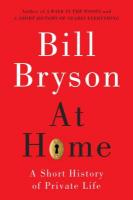
 Another great non-fiction book from one of my favorite authors. The author grabs inquisitive readers’ attention from the beginning: It starts by Bryson pondering why all of our dining tables display salt and pepper shakers rather than other equally common spices, where the expressions “sleep tight” and “room and board” generated, and why does he have decorative buttons on the end of his jacket sleeves. His curiosity is justified; according to his diaries, even Albert Einstein was more preoccupied with the places where he lived and where he vacationed rather than his research.
Another great non-fiction book from one of my favorite authors. The author grabs inquisitive readers’ attention from the beginning: It starts by Bryson pondering why all of our dining tables display salt and pepper shakers rather than other equally common spices, where the expressions “sleep tight” and “room and board” generated, and why does he have decorative buttons on the end of his jacket sleeves. His curiosity is justified; according to his diaries, even Albert Einstein was more preoccupied with the places where he lived and where he vacationed rather than his research.
With the American fascination for houses and home remodeling, this book covers centuries of history of our domestic dwellings. The book starts with a description of unusual usage of houses and furnishings by the Romans, who did not have a specific purpose assigned to each of their rooms. Romans carried their furniture, as the sun light was moving from East to West – from room to room, and followed the light and warmth. The little we known about the Medieval furniture was compiled mostly from children’s rhymes. The book extensively covers two famous American houses – Monticello of George Washington and the Biltmore estate of the Vanderbilt’s, and gives credit to Palladio for his contributions to the architecture of contemporary homes and to Jefferson’s designation as the father of American French fries, as he was the first one to come up with the idea to cut up the potatoes lengthwise and fry them. Bryson covers everything remotely connected to the history of our domestic dwellings: poisoning glue on Victorian wallpaper, the first hostel with the indoor pluming and the first public restrooms. He tells us how the discovery of food preservation by canning caused a major shift in the way the wars were fought.
Bryson has an entertaining style of writing and a great talent for finding a fascinating topic to research and write about. This book will not disappoint any reader interested in learning from a non-fiction book packed with interesting facts about the history of our homes.
